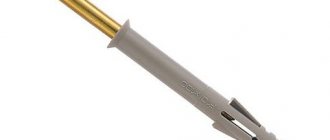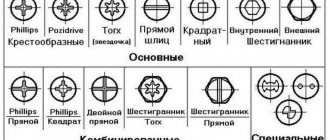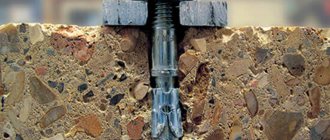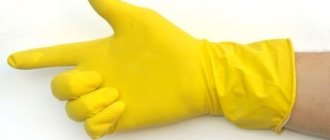When building a house or renovating an apartment, there is often a need to secure some heavy objects, be it a water heater for the bathroom, a wall unit for a child's room, or a china cabinet. And at the same time, a margin of safety is required.
Ordinary dowels with plastic spacers cannot always help in this matter; “heavy artillery” is needed here - these are anchors.
An anchor (“anchor” in German) is a bolt with a thread and a nut; the kit also includes a spacer part; such fasteners are designed for attaching weighty structures. From the photographs you can understand the features of the anchors, as well as their scope of application.
The history of the development of this fastener dates back to 1973, when a German council of experts began working on the calculation of permissible anchor fastenings. And in 1998, the regulation on the use of metal anchors in concrete ETAG 001 was issued.
In addition to solving household repair issues, anchor bolts are used in the construction industry; therefore, there are many types of anchors, from simple ones - created for fixed structures, to specific ones - solving issues of constant pressure and bending on the fastening element.
Advantages and disadvantages of anchor connections
Disadvantages include:
- Expensive cost;
- A lot of installation tools are required (puncher, hammer, screwdriver, wrench);
Advantages:
- Increased safety margin;
- Copes with pull-out loads;
- Long service life;
- Increased level of security.
An important characteristic of anchors is the material of manufacture. Only high-quality structural steel is used to make anchors or durable aluminum-based alloys.
The material used to make anchors must withstand loads and deformations. In addition, resistance to corrosion is an important quality, because anchor connections last for decades, so brass, aluminum and stainless steel are used, which do not rust.
When installing anchors in wet rooms, you should choose them with a thicker galvanized layer.
In land management
Anchor products made of plastic have found application in land management and are used to strengthen banks, construct road embankments and pipelines.
Fastening elements have increased impact resistance and frost resistance, and are able to withstand the effects of groundwater, hazardous chemicals and corrosion.
Plastic fasteners are T-shaped and range from 60 to 120 centimeters in length. When driving into the ground and installing the ATP clip, the fastening elements are connected by a polymer cable and form a three-dimensional geogrid.
Expansion anchors
Expansion anchors are more often used for fastening heavy structures (metal doors). These are metal cylindrical bushings with grooves on the body. When the nut is tightened with a wrench, the bushing expands over the entire surface and rests closely against the base material.
The advantage of these anchors is their ability to withstand heavy loads in the perpendicular and longitudinal directions.
Permissible loads
Yandex.RTB RA-1479455-3
The working loads of all types of anchor fasteners should be no more than 25% of the maximum pull-out load when used in concrete with a strength of 200-250 kgf/cm² (corresponding to concrete grades M200 and M250). As the strength of concrete increases, the recommended load of fasteners increases proportionally. If there are cracks in the concrete, the pull-out load is multiplied by a factor of 0.6.
Fasteners for hollow materials
Double-expansion anchors are metal products consisting of steel bushings mounted on a stud. When tightening the nut on the outside, the bushings located inside diverge, the sleeve is deformed over the entire surface, because The bushings diverge in different spacer zones, which ensures reliable fixation in the wall; anchors of this type are almost impossible to remove after installation.
“Butterfly” anchors with an expansion mechanism are suitable for lightweight structures; they are used to fasten interior parts (pictures, sconces, shelves) to flat materials no thinner than 10 mm (plasterboard, chipboard, plywood).
The “wings” of the anchor open and are tightly fixed on the back side of the material. The reliability of the assembly depends on the base into which the anchor is screwed.
When choosing anchor products, it is necessary to take into account: the characteristics of the material of both the anchor and the base surface, the weight of the fixed equipment, installation principles and, of course, stock up on the necessary tools.
Chemical
Chemical anchors are a type of fastening elements that, in addition to frictional force and material resistance, also use adhesive force through the use of synthetic resins.
This provides additional fixation. Chemical fasteners are used when securing particularly heavy structures or when working with porous and soft materials.
The chemical anchor is usually a standard stud. After drilling the hole, its walls are blown out and covered with adhesive, after which the anchor is inserted. The disadvantage of chemical anchors is that they cannot be used immediately; you must wait until the adhesive reaches maximum strength.
Marking
In order to decide on the choice of certain anchors for concrete, sizes, you can consider the product labeling. The permissible load is indicated in product certificates, and on price tags - physical parameters that must be observed when using fasteners. The decoding using the example of the M8 10/35*90 product looks like this:
- M8 - diameter of the thread applied to the shaft of a bolt or stud;
- 10 - diameter of the seat and drill for drilling it out;
- 35 - permissible thickness of the structure being fixed;
- 90 is the minimum size of the hole recess for the anchor clamp.
Drill for concrete Source www.texnik52.ru
The dimensions of anchor bolts for concrete vary depending on the purpose. So, for domestic needs it is enough to limit yourself to a diameter of 12 mm and a length of 20 cm. For heavy structures, the parameters are increased to 20 mm and 35 cm, respectively. This suggests that the thickness for fixed structures can be 1.5-6 cm, and for a load-bearing base - 5-30 cm.
How to remove an anchor bolt from concrete
Anchor bolts are usually fixed in concrete. To remove an anchor bolt from concrete, all you need to do is unscrew the bolt from the anchor. Occasionally, problems arise with stubborn fasteners that do not want to unscrew; in this case, follow the instructions below.
Step 1
Select a socket wrench that matches the size of the bolt nut. Many bolts have the size printed on the top of the head.
Step 2
Remove the concrete bolt using a wrench. If it is rusty, lubricate it with oil, diesel fuel, gasoline or antifreeze and wait until the liquid is absorbed. After it is absorbed, try the key again.
Step 3
If the bolt is stubborn and won't come out, you might want to try a puller. Attach the puller to the drill and place it on the bolt. Drill into the concrete to the base of the bolt. Pull out the bolt using pliers.
Step 4
Insert the awl into the hole. Give the awl a few sharp blows with a hammer until it cuts all the way down to the base. Remove the bolt parts using pliers.
Step 5
If none of the previous methods helped, saw off the bolt head with a grinder. Sand or cut the top of the bolt so that it is below the surface of the concrete. Remove debris and fill the hole with concrete.
Anchoring of building structures
Anchor elements ensure the transfer of the load from attached objects to the anchor base, which can be a load-bearing or non-load-bearing building structure.
A wide range of natural and industrial materials can be secured with anchor bolts. The load on the base can be static or dynamic.
The environment in which anchor elements are placed also has a fundamental influence on their selection in terms of influencing the material of the anchors, whether they are embedded in the structure or located in an open space, air gap.
Attaching objects can be done in two ways.
- Having secured the anchor bolts in advance;
- Additional fastening of anchors.
Anchoring can be done in bricks, concrete, metals, plastics and wood. For these purposes, materials can be divided into groups according to the cubic capacity of the material:
- With low cubic strength below 10 MPa. Such materials include solid brick masonry, hollow brick masonry, plasterboard, foam concrete;
- With cubic strength from 10 to 50 MPa. These materials can be used to remove and install anchors with high load-bearing capacity. This group includes high-strength brickwork and concrete;
- Cubic strength more than 50 MPa. Installation of anchor bolts in such structures is impossible.
Fastening to plastic and wood is carried out by a simple technology of hammering various nails manually or pneumatically. Another way is to drill out the screws.











